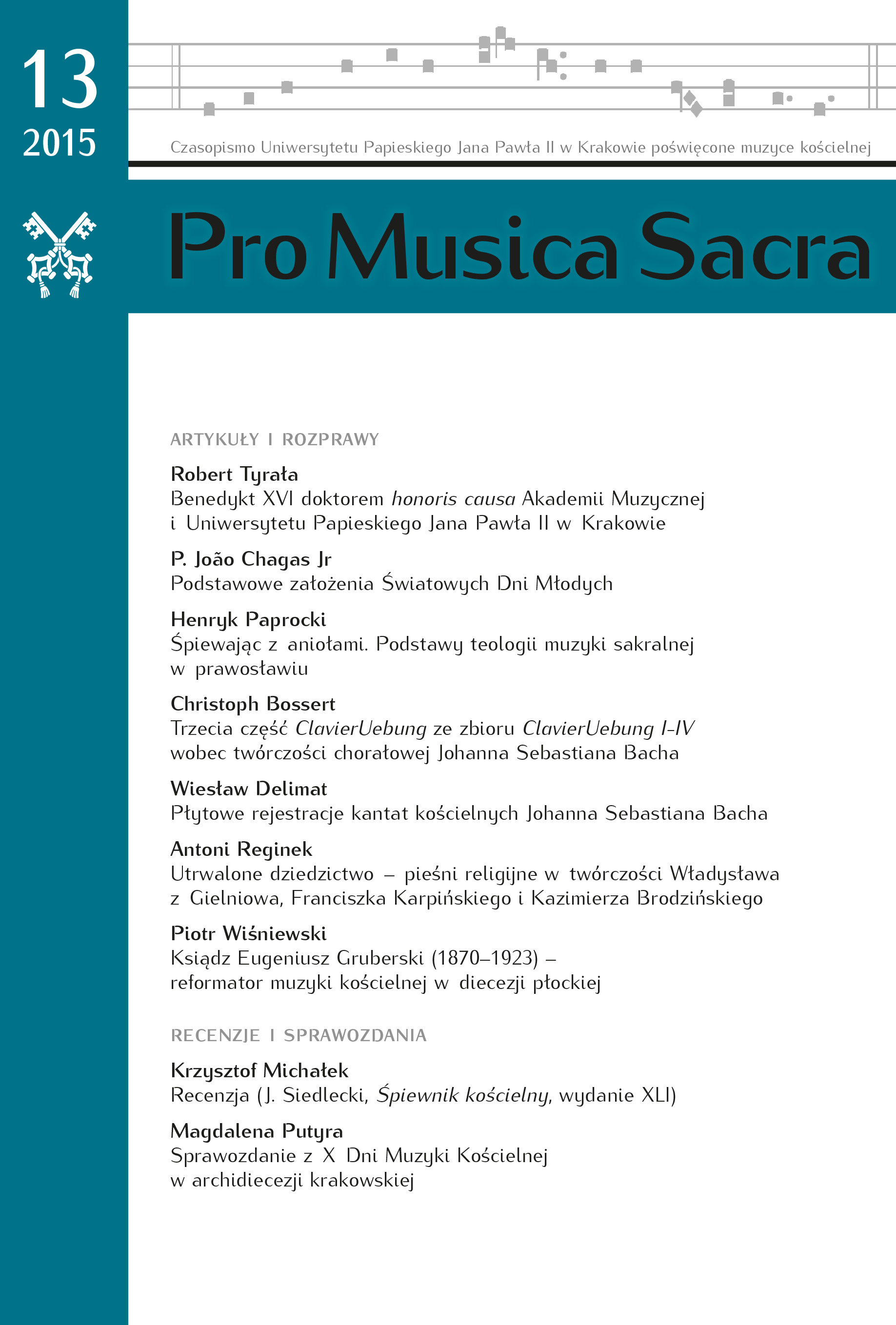Próba przybliżenia zagadnienia symboliki liczb w muzyce Johanna Sebastiana Bacha w kontekście historycznym oraz badań Christopha Bosserta i grupy Bach-Societät
DOI:
https://doi.org/10.15633/pms.1117Słowa kluczowe:
Johann Sebastian Bach, symbolika, gematria, Christoph Bossert, Lorenz Mitzler, gesamttakt, symetriaAbstrakt
In 1947 Friedrich Smend has developed the theory about numerological symbolism in Bach’s music. In similar way to the cabalistic gematria, he discovered, the coinherence of symbolic name “Bach” as the number 14, and “J.S.Bach” as 41. He claimed that it is possible to find that Bach has used that symbolism in his compositions. The exaple of this operation is possible to find in the first part of ClavierÜbung: this work is made from 41 movements, and was published as the first printed work from Bach in his life. And Bach started to write this work as he was 41 years old. On the Hausmann painting, Bach has got the manuscript contain fragment of 14 canons. The painting was made because of Bach’s joining as 14th member to the Mitzler Society. Those simple conclusions lead to establish the international searching group for common platform for music, theology and symbolical numbers in Bach’s ouvre. This group has mainly researched the text-based works, and did not focus on the correspondence among the series-work of Bach. Profesor Christoph Bossert with his over 20 years of his research work discovered the special code, which Bach might to used for his compositions. Based on that discoveries, he constitute the Bach-Societät group, which is focused on researches and discovering connections among the theology, symbolism and musical structures in whole Bach’s music.
Bibliografia
Blankenburg W., Einführung in Bachs h-moll Messe, 1974 Kassel.
Bossert C., Das Bach-Kunstprojekt Halberstadt, ein Kunstprojekt in Kunstprojekt, Würzburg 2011.
Bossert C., Hauptfamilien in WK I, [w:] Bach-Seminar Arnstadt 2013, cz. 3 Anhänge, Arnstadt 2013.
Felbick L., Lorenz Christoph Mitzler de Kolof – Schüler Bachs und pythagoreischer „Apostel der Wolffischen Philosophie”, Hildesheim 2012.
Festschrift für Friedrich Smend zum 70. Geburtstag dargebracht von Freunden u. Schülern, Berlin 1963.
Forkel J. N., Über Johann Sebastian Bachs Leben, Kunst und Kunstwerke, Lipsk 1802.
Halter M., Le judaisme raconte a mes filleuls, Paris 1999, wyd. polskie M. Halter, Judaizm – opowieść dla moich chrześniaków, przekł. K. Skawina, Warszawa 2001.
Karpowicz-Zbińkowska A., Wszystkie drogi prowadzą do Bacha, „Christianitas” 48/49 (2012).
Kee P., Mass und Zahl in Passacaglia und Ciaccona – Astronomie in Buxtehudes Passacaglia, „Ars Organi” 32 (1984), s. 232–241.
Mitzler L. C., Musikalische Bibliothek, t. 1, Leipzig 1738.
Prautzsch L., Die verborgene Symbolsprache Johann Sebastian Bachs, Zeichen und Zahlenalphabet auf den Titelseiten der Kirchenmusik, t. 1, Kassel 2004.
Schweitzer A., Jean Sebastien Bach, le musicien poete, Paris 1905; wyd. niem. Leipzig 1908; wyd. polskie A. Schweitzer, Johann Sebastian Bach, przekł. M. Kurecka i W. Wirpsza, Kraków 1987, Kraków 1987.
Siebigke L. L., Johann Sebastian Bach. Nebst einer kurzen Darstellung seines Lebens und seiner Manier, [w:] Museum deutscher und gelehrter Künstler, t. 2, Breslau1801.
Smend F., Johann Sebastian Bach: Kirchen Kantaten: erläutert, T. 3,, Berlin 1947.
Dokumentation und Bibliographie der Internationalen Arbeitsgemeinschaft für Theologische Bachforschung 1976–1996, Hrsg. R. Steiger, Berlin 1998.
Tatlow R., Collections, Bars and Numbers: Analytical Coincidence or Bach’s design? „Understanding Bach” 8 (2007), s. 37–58.
Werckmeister A., Musicalische Paradoxal-Discourse, Quedlinburg 1707.
Zawistowski P., Rozważania na temat retoryki w muzyce baroku, Białystok 2003, s. 24 (Z Praktycznych Zagadnień Pedagogiki Muzycznej. Zeszyt Naukowy Filii AMFC, 2).
http://reader.digitale-sammlungen.de/de/fs1/object/goToPage/bsb10599089.html?pageNo=423 (31.03.2015).
http://www.bachnetwork.co.uk/ub2/tatlow.pdf [dostęp: 31.03.2015].
Pobrania
Opublikowane
Numer
Dział
Licencja
Autorzy publikujący w czasopiśmie udzielają jego wydawcy zgody o następującej treści:
- Autor zachowuje autorskie prawa majątkowe do utworu, a jednocześnie udziela wydawcy czasopisma zgody na jego pierwszą publikację w wersji drukowanej i wersji online na licencji Creative Commons Uznanie autorstwa 4.0 Międzynarodowe oraz zgody na wykonywanie opracowań, w tym przekładów.
- Autor ma możliwość udzielania zgody niewyłącznej na opublikowanie utworu w wersji, która ukazała się w czasopiśmie (np. zamieszczenia go w repozytorium instytucjonalnym lub opublikowania w książce), wraz z informacją o jego pierwszej publikacji w czasopiśmie.
- Autor może umieścić swój utwór online (np. w repozytorium instytucjonalnym lub na swojej stronie internetowej) jeszcze przed zgłoszeniem utworu do czasopisma.

